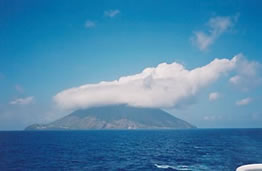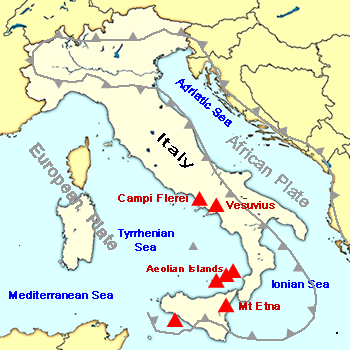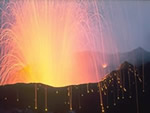 Stromboli Volcano:Aeolian Island: Italy
Stromboli Volcano:Aeolian Island: Italy
World volcano Profiles >Europe > Stromboli
Stromboli is an Italian volcanic island is the top of a volcano which emerges from the Tyrrhenian Sea and is part of the Aeolian volcanic islands off the North East coast of Sicily. The cone rises 924m above sea level and the volcano has been continuously erupting for at least the last 2000 years.
The Geology Bit
 Stromboli forms part of Calabrian Island Arc. The Tectonic setting of the Mediterranean can be complicated but essentially the volcanic activity here is caused by the westwards subduction of the African plate beneath the European plate containing Sicily and the Tyrrhenian sea. This type of setting typically produces explosive and violent eruptions like those of Vesuvius but Stromboli seems to have a continuously open vent which allows frequent eruption of lava bombs and incandescent lava fragments every few minutes of hours. This style of eruption is called Strombolian.
Stromboli forms part of Calabrian Island Arc. The Tectonic setting of the Mediterranean can be complicated but essentially the volcanic activity here is caused by the westwards subduction of the African plate beneath the European plate containing Sicily and the Tyrrhenian sea. This type of setting typically produces explosive and violent eruptions like those of Vesuvius but Stromboli seems to have a continuously open vent which allows frequent eruption of lava bombs and incandescent lava fragments every few minutes of hours. This style of eruption is called Strombolian.
What to see and How to see it?
The best way to climb Stromboli is with a guide. At 924m this is around 3000ft to the top. The most popular way to ascend the volcano is in late afternoon so that the summit fireworks can be seen after dark. Descending the mountain in darkness without a guide is not recomended and would be decidedly hairy. The tourist office will help you find a suitable guide and one that is sanctioned by the Club Alpino Italiano Office on the island.
Stromboli can be reached by ferry from the Sicilian mainland and other Aeolian islands. There are no cars on the island, but golf carts and mopeds!
 The summit most people climb to is the Pizzo sopra la Fossa at 918m. The path follows the waterfront past Ficogrande and then turns upwards to the observatory at Punta Labronzo. It is then worn and sunken zig zag path upwards to a rock refuge before a final ridge walk to the top. The Sciara del Fuoco is on your right, and is a steep slope down which many of Strombolis bombs and lava fall.The ridge walk may be done after dark so a headtorch is absolutley essential.
The summit most people climb to is the Pizzo sopra la Fossa at 918m. The path follows the waterfront past Ficogrande and then turns upwards to the observatory at Punta Labronzo. It is then worn and sunken zig zag path upwards to a rock refuge before a final ridge walk to the top. The Sciara del Fuoco is on your right, and is a steep slope down which many of Strombolis bombs and lava fall.The ridge walk may be done after dark so a headtorch is absolutley essential.
The whole walk to the top ,at a steady pace, takes 4 hours or so. If its dark you will not be able to see the detail of the circular depression at the top. The active vents are 100-150m below the walking summit and you probably heard and smelt them on the way up. There are currently three craters which regularly eject lava into the air up to 300m but more commonly 100m. Stromboli can behave erratically and lingering at the summit for too long may put you at risk from bombs.
The descent can be the ascent route or down the "moonwalk" path which is a long descent down an ash slope líke walking down a giant sanddune. The path then becomes sunken and vegetated before emerging onto a track and finally Stromboli town. The whole ropund trip can take 6-7 hours depending on conditions so is not suitable for young children.
Adequate warm clothing,food and drink is a must for this trip as it can be cold at the top and at rest stops. Walking poles, gaitors, headtorch and facemask are strongly reccomended. A hardhat should be provided by the guide and possibly a facemask.
Stromboli Links
New Ascent regulations from August 2007www.volcanodiscovery.com
www.etnatrekking.com
www.volcanotrek.com
Global volcanism project
Stromboli Online:Stromboli
Volcanoworld.Strombo


